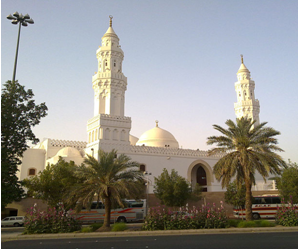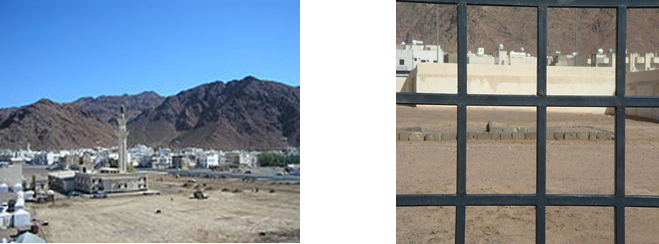AlMadinah AlMunawarrah
AlMadinah Al Munawwarah is the capital of “AlMadinah Province”. (the ‘radiant city’ or the “enlightened city” or simply called: Madinah the ‘City of the Prophet’ is the second holiest site in Islam after Makkah. It is situated in the Hejaz region of Western Saudi Arabia about 340km north of Makkah and has a population of 1,512,724, similar to Makkah. Entry to AlMadinah is restricted to Muslims only as it is a holy place.
AlMadinah is home to three very important mosques in Islam:
1) The most famous, “AlMasjid AlNabawi”; The Prophet’s Mosque was built on the site of his home. The second holiest mosque in Islam. Prophet Muhammad and his first two Caliphs Abu Bakar and Umar were buried under the Green Dome of the mosque.

2) “Masjid Quba” is the first mosque of Islam 622 A.D. The Quba Mosque, in the outlying environs of Medina is the oldest mosque in the world.

3) Masjid AlQiblatain, where the Qiblah was switched to Makkah. It is historically important as being the place where the Prophet Muhammad leading the prayer has been commanded to switch the direction of prayer from Jerusalem to Makkah.
 Points of Interest
Points of Interest
Al-Baqi’ Cemetery
 “Maqbaratul Baqi” is a cemetery in Medina, located to the southeast of the Masjid al-Nabawi.
“Maqbaratul Baqi” is a cemetery in Medina, located to the southeast of the Masjid al-Nabawi.
Burials: Fatima bint Muhammad, Muhammad al-Baqir, Uthman ibn Affan, Hasan ibn Ali, Ja’far al-Sadiq, Imam Shamil, Ali ibn Husayn Zayn al-Abidin, Malik ibn Anas, Ruqayyah bint Muhammad, ‘Abbas ibn ‘Abd al-Muttalib, Idris of Libya, Muhammad Sayyid Tantawy, Uthman bin Maz’oon, Fatimah bint Asad, Mohammad Hayya Al-Sindhi, Hasan as-Senussi Mor
Mount UHUD
 Martyrs of UHUD
Martyrs of UHUD
At the foot of Mount Uhud contains in the center the graves of “Sayedna Hamza” (May Allah be pleased with him), “Mus’ab bin Umair” (mau Allah be pleased with him) who were martyred in the battle of Uhud.
The Battle of Uhud (Arabic: غزوة أحد Ġazwat ‘Uḥud) was fought on Saturday, March 19, 625 (3 Shawwal ) at the valley located in front of Mount Uhud. It occurred between a force from the Muslim community of Medinah led by the Prophet Muhammad, and a force led by Abu Sufyan ibn Harb from Makkah, the town from which many of the Muslims had previously emigrated. The Battle of Uḥud was the second military encounter between the Makkans and the Muslims, preceded by the Battle of Badr in 624, where a small Muslim army had defeated a larger Makkans army. For the Muslims, the battle was a significant setback: although they had been close to routing the Makkans a second time, their breach of Muhammad’s orders in favor of collecting Makkans can spoils reaped severe consequences. The two armies would meet again in 627 AD at the Battle of the Trenchغزوة الخندق .
The Hijri Year
Hijra; the migration of the Prophet and his followers to Madinah marked the beginning of the Islamic calendar the corresponding to the year 622AD. The first month should be ‘Zul Hajj’ as that is the month of the pilgrimage. “Usman” suggested that because throughout the Arabian Peninsula the year was calculated as starting with Muharram, the new era should also start with Muharram. This suggestion was accepted. The date was accordingly pushed back by two months and eight days, and the new Hijri calendar began with the first day of “Muharram” in the year of migration rather than from the actual date of migration. “Umar bin Al-Khattab” accordingly issued instructions to all concerned regarding the enforcement of the Hijri calendar.
Mada’in Saleh
 Madain Saleh is a pre-Islamic archaeological site located in the Al-Ula sector, within the Al Madinah Region, approximately 400km north-west of AlMadinah. Formerly known as El Hijr, Hegra it is the largest conserved site of the civilization of the Nabataeans south of Petra in Jordan. The site features 131 massive rock cut tombs with decorated facades, many with inscribed Nabatean epigraphs, spread out over 13.4 km and dating from the 1st century BC to the 1st century AD. Madain Saleh is an outstanding example of the Nabataeans’ architectural accomplishment and hydraulic expertise.
Madain Saleh is a pre-Islamic archaeological site located in the Al-Ula sector, within the Al Madinah Region, approximately 400km north-west of AlMadinah. Formerly known as El Hijr, Hegra it is the largest conserved site of the civilization of the Nabataeans south of Petra in Jordan. The site features 131 massive rock cut tombs with decorated facades, many with inscribed Nabatean epigraphs, spread out over 13.4 km and dating from the 1st century BC to the 1st century AD. Madain Saleh is an outstanding example of the Nabataeans’ architectural accomplishment and hydraulic expertise.

